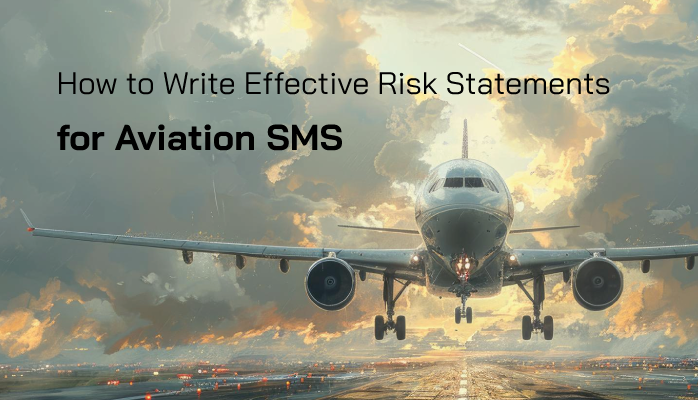What Are Risk Statements in Aviation SMS Risk Management?

Aviation Safety Management Systems (SMS) are the backbone of modern aviation safety, providing a structured approach to
- identifying hazards,
- assessing risks, and
- implementing controls to ensure safe operations.
At the heart of an effective SMS lies the ability to communicate potential safety risks clearly and concisely through risk statements. These statements are essential tools for aviation safety managers, enabling them to convey critical safety information to stakeholders, prioritize mitigation efforts, and foster a proactive safety culture.
This comprehensive guide explores how to craft effective risk statements for Aviation SMS during the risk management process. We offer timeless strategies grounded in
- industry best practices,
- regulatory guidelines, and
- real-world examples.
By mastering the art of writing risk statements, safety managers can enhance their organization’s safety performance and ensure compliance with international standards, such as those set by the International Civil Aviation Organization (ICAO).
Understanding Risk Statements in Aviation SMS
What is a Risk Statement?
A risk statement is a succinct description of a potential safety risk associated with an identified hazard. It typically follows a structured format that outlines:
- The Condition: The circumstance or hazard that could lead to a risk (e.g., "If...").
- The Consequence: The potential negative outcome if the risk materializes (e.g., "Then...").
For example: "If foreign object debris (FOD) is not cleared from the runway, then there is a risk of aircraft damage or loss of control during takeoff or landing."
Risk statements are integral to the Safety Risk Management (SRM) component of an SMS, which involves identifying hazards, analyzing risks, and implementing controls to achieve an acceptable level of safety.
Why Are Risk Statements Important?
Risk statements serve multiple purposes within an SMS:
- Clarify Risks: They pinpoint specific hazards and their potential impacts, making abstract safety concerns tangible.
- Support Decision-Making: They provide data-driven insights for prioritizing resources and mitigation strategies.
- Enhance Communication: They ensure that risks are understood by diverse stakeholders, from frontline employees to top management.
- Promote a Safety Culture: By making risks visible, they encourage proactive engagement in safety practices.
Related Articles on Safety Culture in Aviation SMS
- What Is Safety Culture in the Aviation Industry?
- 5 Characteristics of Effective Aviation Safety Cultures - With Free Survey
- 6 Signs of a Mature Aviation Safety Culture
Effective risk statements are critical for aligning organizational efforts toward safety goals and meeting regulatory requirements, such as those outlined in ICAO’s Safety Management Manual (Doc 9859).
Key Elements of Effective Risk Statements
To be effective, risk statements must incorporate several key elements that ensure clarity, relevance, and actionability. These elements are derived from industry best practices and guidelines, such as those from MITRE.
| Element | Description |
|---|---|
| Clarity and Conciseness | Use simple, straightforward language to ensure accessibility for all stakeholders. |
| Realistic Scenarios | Focus on plausible risks based on actual hazards, avoiding exaggerated outcomes. |
| Structured Format | Employ the "If... Then..." format to clearly separate the condition and consequence. |
| Causes and Factors | Include root causes or contributing factors to provide context for mitigation. |
| Audience Tailoring | Adapt the level of detail to suit different stakeholders (e.g., management vs. staff). |
1. Clarity and Conciseness
Risk statements should be easily understood by individuals with varying levels of aviation expertise. Avoid technical jargon or overly complex phrasing. For example, instead of "If suboptimal meteorological conditions persist," use "If adverse weather conditions continue."
2. Realistic Scenarios
Base risk statements on hazards identified through systematic processes, such as safety audits or incident reports. Avoid "worst-case" scenarios that are unlikely, as they can undermine credibility. For instance, focus on common issues like equipment failure rather than rare catastrophic events.
3. Structured Format
The "If... Then..." format is widely recommended for its logical structure. It clearly delineates the hazard (If) from the potential outcome (Then). For example: "If maintenance personnel do not follow pre-flight checklists, then there is a risk of mechanical failures during flight."
4. Inclusion of Root Causes and Contributing Factors
Effective risk statements provide insight into why a risk exists by mentioning root causes or contributing factors. This context helps stakeholders understand the risk’s origins and identify mitigation strategies. For example: "If pilots lack regular training on adverse weather, then there is a risk of flight disruptions due to inadequate handling skills."
Related Root Cause Analysis Articles
- How to Conduct Root Cause Analysis in Aviation SMS
- Proactive Risk Management: What Root Causes Say About Management
- Understanding "Root Cause Analysis" Charts in Aviation SMS Dashboards
5. Tailored to the Audience
Different stakeholders require different levels of detail:
- Top Management: Needs high-level summaries to inform strategic decisions.
- Frontline Employees: Requires specific, actionable details to address risks in daily operations.
- Regulators: Expects detailed documentation to ensure compliance.
Tailoring ensures that risk statements are relevant and actionable for each audience.
Best Practices for Writing Risk Statements
Crafting effective risk statements requires a systematic approach and adherence to best practices. The following strategies can guide safety managers:
1. Adopt a Systematic Approach
Use established methodologies, such as MITRE’s "If... Then..." format, to ensure consistency and clarity. This approach aligns with the SRM process, which involves hazard identification, risk assessment, and control implementation.
2. Conduct Thorough Risk Assessments
Before writing a risk statement, perform a comprehensive risk assessment:
- Identify Hazards: Use reactive (e.g., incident reports) and proactive (e.g., safety audits) methods.
- Analyze Risks: Assess the likelihood and severity of potential outcomes.
- Determine Consequences: Identify the most probable negative impacts.
A robust risk assessment ensures that statements are grounded in data and relevant to operations.
Related Articles on Risk Assessments in Aviation SMS
- 4 Pillars | What Is Risk Assessment in Aviation SMS
- What Are Hazard Risk Assessment and Hazard Risk Analysis in Aviation SMS
- How to Identify Hazards and Assess Risks in Aviation SMS - With Free Resources
3. Engage Stakeholders
Involve frontline employees, subject matter experts, and management in the development process. Their insights into operational realities can enhance the accuracy and practicality of risk statements. For example, pilots can highlight specific risks related to weather conditions, while maintenance staff can identify equipment-related hazards.
4. Regularly Review and Update
Safety risks evolve with changes in operations, technology, or regulations. Periodically review risk statements to ensure they reflect current conditions. Update them as new hazards are identified or mitigation strategies are implemented.
5. Communicate Effectively
Risk statements should be shared with all relevant stakeholders through appropriate channels:
- Urgent Risks: Use SMS databases or electronic message boards for immediate communication.
- Long-Term Risks: Include in "Lessons Learned" documents or safety briefings.
- Regulatory Compliance: Document in SMS manuals for audits.
Effective communication ensures that risk statements drive action and awareness.
Examples of Effective Risk Statements
To illustrate these principles, here are examples of risk statements across various aviation contexts:
| Context | Risk Statement |
|---|---|
| Operational | If pilots do not receive regular training on adverse weather conditions, then there is an increased risk of flight disruptions or accidents due to improper handling of weather-related challenges. |
| Maintenance | If maintenance personnel do not follow prescribed checklists for pre-flight inspections, then there is a risk of mechanical failures during flight, potentially leading to emergency landings or accidents. |
| Human Factors | If air traffic controllers are overworked due to staffing shortages, then there is an increased risk of communication errors or delays in air traffic management, which could compromise flight safety. |
| Aerodrome | If foreign object debris (FOD) is not cleared from the runway, then there is a risk of aircraft damage or loss of control during takeoff or landing, potentially leading to accidents. |
These examples demonstrate the "If... Then..." format, include causes, and are tailored to specific operational contexts.
Tools and Resources for Writing Risk Statements
Several tools and resources can support aviation safety managers in crafting and managing risk statements:
- Aviation Risk Management Software: Platforms like SMS Pro offer features for hazard reporting, risk assessment, and statement generation, streamlining the SMS process.
- Regulatory Guidelines:
- ICAO Safety Management Manual (Doc 9859): Provides a framework for SMS, including risk management processes.
- FAA Advisory Circular 120-92: Offers guidance on SMS implementation and risk communication.
- Industry Resources:
- SKYbrary: Offers articles on risk management best practices.
- SMS Pro's Aviation Safety Blog: Provides practical tips and examples for SMS implementation.
- Training Programs: Organizations like The Aviation Consulting Group (TACG) offer ICAO-compliant SMS training, including risk management modules.
Conclusion
Writing effective risk statements is a critical skill for aviation safety managers, enabling them to communicate safety risks clearly and drive proactive mitigation efforts. By focusing on clarity, realism, structure, and stakeholder engagement, safety managers can craft statements that enhance their SMS and foster a robust safety culture.
Regular reviews, thorough risk assessments, and the use of tools like SMS Pro software ensure that risk statements remain relevant and actionable.
As aviation continues to evolve, the ability to articulate risks through well-crafted statements will remain a cornerstone of safety management. By applying the strategies outlined in this guide, safety managers can strengthen their organization’s safety performance and contribute to safer skies.
Call to Action: Start refining your risk statements today by conducting a risk assessment or reviewing existing statements. Share your experiences or challenges in the comments below, and let’s collaborate to advance aviation safety.
What is the best risk statement you have written? Would you please provide an example for the group?
Live SMS Pro Demo
Let's work together. You reduce your risk when you have an SMS data management partner.
Key Citations
- Risk Management | SKYbrary Aviation Safety
- ICAO Safety Management Manual (Doc 9859)
- FAA Advisory Circular 120-92
- MITRE’s Risk Statement Guidelines
- SMS Pro Aviation Safety Management System
Last updated October 2025.







